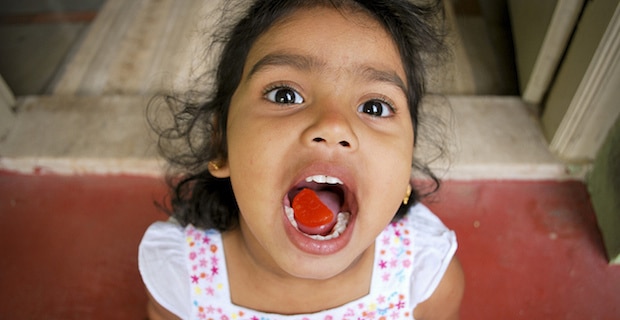
ADHD (Attention Deficit Hyperactivity Disorder) is a diagnosis given to children that exhibit symptoms of hyperactivity, impulsivity, and distractibility. Other symptoms include fidgeting, squirming, inability to listen, forgetfulness, and lack of response to discipline. According to the Centers for Disease Control, approximately 5% of children have ADHD, although other studies have put the estimate between 8-10% of school-aged children.
In the majority of cases, children with ADHD are put on Ritalin. Although this drug may be helpful to some children, in a fair number of cases, Ritalin does not help with behavioral problems and may even exacerbate symptoms.1 As a result, many parents are seeking a natural approach to dealing with their child’s behavioral issues. Considerable research has been done to investigate the link between food and symptoms associated with ADHD, much of which indicates that a high percentage of children exhibiting ADHD tendencies have increased sensitivities to some foods and additives common in the typical American diet.
The following is a list of the more common food-based reactions of children with ADHD. This list is not comprehensive.
Food Allergies
Food allergies and sensitivities are more common than one might expect. They often get under-diagnosed because traditional allergists tend to focus their search to spotting the presence of IgG, a specific antibody reaction, when in fact other relevant antibody reactions may be triggered elsewhere in the body.
Read more about identifying food allergies and sensitivities
The most common foods that children react to are dairy, wheat, other gluten containing grains (i.e. rye, barley, spelt, etc…), eggs, yeast, soy, corn, chocolate, and citrus. Other foods besides these can trigger symptoms. To improve hyperactive behavior associated with allergic reactions, it is important to completely eliminate the offending food.
Additives
The foods we eat today are loaded with additives. Additives are included in foods to add flavor and color, help improve texture, and preserve freshness. Additives can elicit a reaction from those that eat them, especially those that are sensitive. The challenge is not always easy to determine if your child is sensitive, especially if they are consuming additives on a regular basis. Food color (such as tartrazine or yellow #5) and sodium benzoate have been linked to hyperactivity in studies that examine the effect of diet on children’s behavior.1
Salicylates
According to Dr. Feingold, creator of the Feingold Diet, salicylates may be another problem for some children. Salicylates are aspirin-like compounds present in certain foods and can trigger specific brain reactions in sensitive children leading to changes in their behavior. Salicylates are found in many foods such as almonds, apricots, and some apples. A full list and protocol can be obtained from Dr. Feingold’s organization.
Sugar
Even though a number of studies aim to disprove the link between the consumption of sugar and hyperactive behavior, personal accounts from parents tell a different story. A large number of parents report noticing that their child’s behavior alters with the intake of sugar, leading to increased restlessness and agitation. One of the damaging effects sugar has on the body is the disruption of blood sugar levels, potentially bringing on symptoms of hypoglycemia, subsequently having very real effects on behavior. As well, because sugar can feed unfavorable yeast in the gut, it can lead to problems that stem from an imbalance in important flora in the intestinal tract. This imbalance in micro-flora, also known as dysbiosis, can affect mood and behavior.
Read more about gut bacteria and dysbiosis
Parents may want to consider trying an elimination diet with their child to ascertain whether there is a connection between the foods and additives consumed and the exhibited behavior. An elimination diet consists simply of removing all potentially stimulating substances from your child’s diet for 2 weeks and then reintroducing them one at a time, with a space of 4 days between each new reintroduction. An elimination diet should allow you to note any change in behavior that results from the reintroduction of a substance, allowing a parent to identify dietary culprits.
Image: Harsha K R
References
1 Ward, N. I. et al. The influence of the chemical additive tartrazine on the zinc status of hyperactive children: A double-blind placebo-controlled study. Journal of Nutritional Medicine. 1: 1990. 51-5




